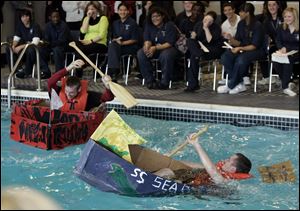
Maritime Academy students test cardboard buoyancy
5/4/2011
Pilots Joel Snyder, left, and Austin Mattimore attempt to stay afloat during the annual Great Cardboard Boat Race at the Maritime Academy in Toledo. Snyder won the race.
As a boat-building material, cardboard lacks certain necessary qualities, not the least of which is the ability to stay afloat.
That’s a lesson a group of students at the Maritime Academy of Toledo learned Wednesday as they raced flimsy vessels built as part of their nautical curriculum.
The scene was the pool at the school’s building on Water Street. The race itself consisted of three cardboard boats paddled back and forth. The idea was to go four lengths, but, unsurprisingly, not all of the boats succeeded.
The competitors were sophomores, organized into teams. Each team was responsible for the design and construction of its one-person boat. The building materials were the essence of simplicity: cardboard, glue, and duct tape no wider than three inches.
The winner was the Red and Black Team, whose boat was the last one to sink. Team member Christophe Ide, 15, said their ace in the hole was the round bow they gave their elfin pinnace.
“It cut through the water beautifully,” he explained.
Cheering students filled the pool room, howling with laughter as one by one the competing boats sank, dunking the paddler.
The races involved math, science, and construction and were more than just a good time, according to Leah Williams, the academy’s principal.
“They talk about theories of how this boat will float. It’s an integrated project. It’s also a bit of fun,” she acknowledged.
She said the student racers are in the academy’s marine career technology program, operated in conjunction with Owens Community College. By the time they get their diploma, they’ll have earned 30 credit hours toward a two-year degree at Owens.
About the main material used, Rick Brown, the boat-building instructor, said, “Cardboard will sink, and it won’t. Last year we had four boats and none sank.”
The students had a week to complete their boat-building project. They started with a scale model, then went to work on the actual racing boat.
Mr. Brown said the academy is the only high school in the state in which students can earn the Basic Safety Training certificate for mariners. There’s also a program that teaches navigation, welding, and small engine repair that qualifies them for entry level jobs on Great Lakes ships, he said.
Christophe said the racing project taught him that “being a naval architect is really difficult.” After graduation, he plans to join either the Military Sealift Command, which operates noncombatant, civilian-crewed ships for the Navy, or the Coast Guard.
Contact Carl Ryan at:
carlryan@theblade.com
or 419-724-6050.